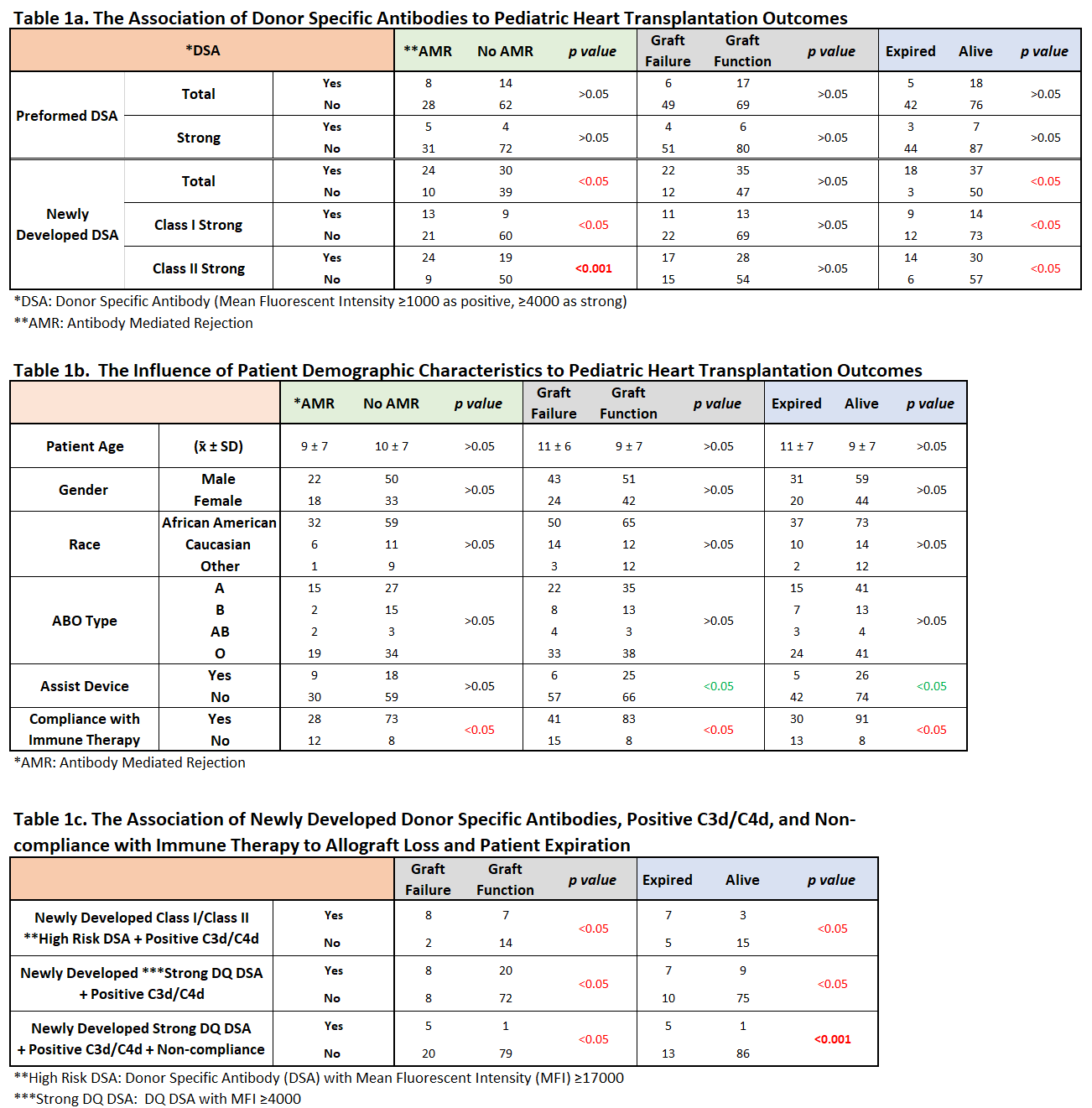The Co-Occurrence of Newly Developed HLA Donor Specific Antibody and Positive C3d/C4d Profiles Along with Immune Therapy Non-Compliance in Pediatric Heart Transplant Recipients is a High Risk Indicator for Patient Mortality
Cleveland Clinic Foundation Transplant Center, Cleveland, OH
Meeting: 2021 American Transplant Congress
Abstract number: 582
Keywords: Antibodies, Heart transplant patients, Histocompatibility, Outcome
Topic: Basic Science » Histocompatibility and Immunogenetics
Session Information
Session Name: Histocompatibility and Immunogenetics
Session Type: Poster Abstract
Session Date & Time: None. Available on demand.
Location: Virtual
*Purpose: Increasing evidence has implicated the deleterious effect of HLA donor specific antibody (DSA) in pediatric heart transplantation (PHTx). However, there are still insufficient research results illustrating the comprehensive predictors that lead to severe graft failure and mortality. This study sought to investigate the degree to which DSA has contributed to negative PHTx outcomes in correlation with other potential detrimental factors.
*Methods: A total of 155 recipients (164 allografts) who underwent PHTx between 1985-2019 were retrospectively analyzed for DSA (Mean Fluorescent Intensity ≥1000 as positive, ≥4000 as strong, ≥17,000 correlated to +C1q as high risk), C3d and C4d, and demographic characteristics (Table 1b). Antibody mediated rejection (AMR), graft failure (GF), and patient expiration (PE) were evaluated as PHTx outcomes. P values were calculated by chi-square or Fisher exact tests for categorical variables and by Wilcoxon rank test for continuous varibles.
*Results: Newly developed DSA (ndDSA) was significantly related to the occurrence of AMR (p<0.05 and p<0.001) and PE (all p<0.05), but not to GF. Preformed DSA had no apparent negative effect on PHTx outcomes (Table 1a). Non-compliance with immune therapy (NC) was significantly associated with AMR, GF and PE (all p <0.05). Median ages of NC vs compliance were 14 (13-18) and 7 (2-14), respectively. Assist devices were correlated with low occurrences of GF and PE (all p <0.05). No other demographic characteristic included in this study displayed an impact on PHTx (Table 1b). High risk and strong DQ ndDSA with positive C3d/C4d showed significant correlation to GF and PE (all p <0.05). Interestingly, the combination of strong DQ ndDSA, positive C3d/C4d, and the additional risk factor of NC demonstrated a dramatic increase in the incidence of PE (p<0.001) (Table 1c).
*Conclusions: High risk and strong DQ ndDSA supported by pathological findings is a critical barrier of successful PHTx for teenaged recipients with immune therapy compliance issues. The co-occurrence of these factors warrant timely enhanced post PHTx management to prevent final allograft failure and patient mortality.
To cite this abstract in AMA style:
Zhang A, Nasman C, Allen J, Sun Y, Thomas D, Rodriguez R, Tan C, Boyle G. The Co-Occurrence of Newly Developed HLA Donor Specific Antibody and Positive C3d/C4d Profiles Along with Immune Therapy Non-Compliance in Pediatric Heart Transplant Recipients is a High Risk Indicator for Patient Mortality [abstract]. Am J Transplant. 2021; 21 (suppl 3). https://atcmeetingabstracts.com/abstract/the-co-occurrence-of-newly-developed-hla-donor-specific-antibody-and-positive-c3d-c4d-profiles-along-with-immune-therapy-non-compliance-in-pediatric-heart-transplant-recipients-is-a-high-risk-indicato/. Accessed July 18, 2025.« Back to 2021 American Transplant Congress

